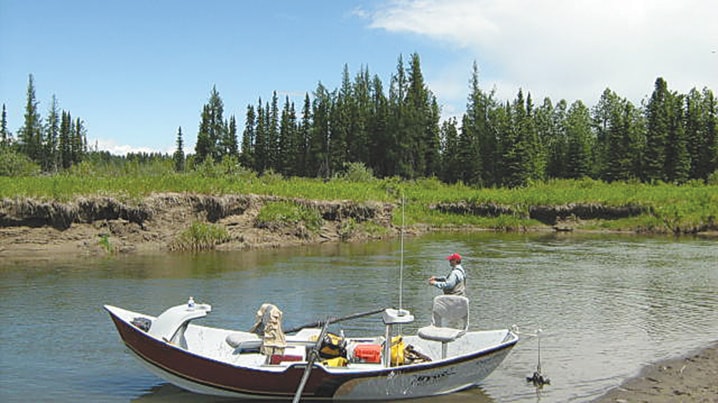The federal government seems determined to pass an omnibus bill that has sections buried in it that would weaken environmental protection from industries that ravage the environment.
In particular, the Tories are intent on gutting the federal Fisheries Act’s habitat protection section that, since 1986, has protected fish habitats in all territories and provinces, and particularly in Alberta. They are gutting good Tory legislation: it was my old first year classmate at Dalhousie Law School, Brian Mulroney, who loved to fish, who toughened up the Fisheries Act shortly after he became prime minister in 1984, creating environmental legislation that Ray Makowecki, a former Alberta fisheries biologist, and now a private fisheries and environmental consultant, says is “as good as it gets.”
Section 35(1) of the Fisheries Act currently reads: “No person shall carry on any work or undertaking that results in the harmful alteration, disruption, or destruction of fish habitat.” The proposed change would omit “habitat” and have section 35(1) read thus: “No person shall carry on any work, undertaking or activity, other than fishing, that results in an adverse effect on a fish of economic, cultural or economic value.”
Otto Langer, former head of habitat protection for the Department of Fisheries and Oceans on the West Coast, says the changes “make the legislation difficult to enforce by introducing vague and obscure wording.”
Carl Hunt, one of Alberta’s legendary “old school” fisheries biologists and a fisheries advocate since he retired, says flatly: “a Fisheries Act without ‘habitat’ will leave Canadians without fish.” Hunt cites the federal government’s own reports showing that Canada, 18 per cent of freshwater and diadromous (spend part of their lives in fresh and salt water) fish in Canada are endangered or threatened in all parts of their ranges. Ray Makowecki says: “Fish habitat is essential to the maintenance of our ever-declining fish resources and the quality of our aquatic ecosystems.”
The Alberta Fish and Game Association has sent a letter to the Prime Minister in which AFGA president, Conrad Fennema, asks: “Who will take on the role of God and decide which fish are of value? We suggest that all fish species are of value in the big picture as every species plays a role in the next one up the chain.”
Will only native fish in Alberta, such as the threatened West Slope cutthroat and our probably soon-to-be designated threatened bull trout, qualify for their cultural and ecological value, and will the habitats of our non-native brown and rainbow trout be excluded?
Or will browns and rainbows, because they provide the best trout fishing in Alberta, come in under the wire for their economic value?’
Section 35 (1) of the Fisheries Act has a strong recent record of protecting various fish habitats in Alberta. I’ll mention just one graphic example of its power.
On Aug. 25th, 2009, the Alberta government itself, as represented by Alberta Tourism, Parks and Recreation and its hired contractor were convicted under section 35 (1) for use of heavy machinery in a bank stabilization project that resulted in infilling and destruction of fish habitat (particularly bull trout) along the Elbow River adjacent to Allen Bill Pond’s day use area.
The judge levied a $95,000 fine and made many orders and set deadlines for the restoration and mitigation of the habitat. I can’t emphasize it enough that in this case, the Alberta government itself was convicted under federal legislation for habitat destruction on an Alberta trout stream. Dare one dream that, some day, the Alberta government might be convicted under section 35 (1) of the federal Fisheries Act and fined for the shameful cattle stomping damage to Alberta trout streams that flow through public land grazing leases?
Having a strong sec. 35(1) is the perfect “out” for Alberta enforcement officers; they can simply call in the feds to avoid the threats to their jobs they often face for standing up for the environment against that peculiar Alberta concept of “progress.” Another plus: In Alberta, most of the fines under sec. 35(1) are ordered to be paid to groups engaged in protection of the environment in general and fish habitat in particular.
If the federal government does gut the strong section 35 (1) as it is now, Alberta’s fisheries biologists and enforcement officers may be left with only the untried provisions of section 54 of Alberta’s Public Lands Act, which does not mention “habitat”, but does prohibit the doing of any act on public land (the beds and shores of rivers, lake and streams) that may “injuriously affect watershed capacity,” or that results in or is likely to result in injury to the bed or shore of any river, stream, watercourse, lake, or other body of water.”
The problem with section 35 (1) of their Fisheries Act, apparently as perceived by the federal Tories, is that it is environmental legislation that is indeed “as good as it gets,” too good in fact for its own good, and therefore must be gutted, weakened, so as not to stand in the way of “progress.”
Bob Scammell is an awarding winning outdoors writer living in Red Deer.
